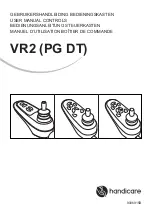
120
mc-22s programming techniques
Preparation, e.g. with a fi xed-wing model aircraft
Programming examples – Fixed-wing models
Programming model data into an mc-22s ...
... is easier than it may appear at fi rst sight.
There is one basic rule which applies equally to all
programmable radio control transmitters – not just
to the mc-22s: if the programming is to go smooth-
ly and the systems work as expected, the receiving
system components must fi rst be installed correctly in
the model, i.e. the mechanical systems must be fi rst-
rate. This means: ensure that each servo is at its cor-
rect neutral position when you fi t the output lever or
disc and connect the linkage to it. If you fi nd this is not
the case, correct it! Remove the output arm, rotate it
by one or more splines and secure it again. If you use
a servo tester, e.g. the Digital Servo Analyzer, Order
No.
763
, to centre the servos, it is very easy to fi nd
the “correct” position.
Virtually all modern transmitters offer facilities for off-
setting the neutral position of servos, but this is no
substitute for a correct mechanical installation; it is
only intended for
fi ne tuning
. Any substantial deviation
from the “0” position may result in additional asymme-
try when the signal undergoes further processing in
the transmitter. Think of it in this way: if the chassis of
a car is distorted, you may be able to force the vehic-
le to run straight by holding the steering wheel away
from centre, but it does not make the chassis any less
bent, and the basic problem of ineffi ciency remains.
Another important point is to set up the correct cont-
rol travels as far as possible by using the appropriate
linkage points in the mechanical system; this is much
more effi cient than making signifi cant changes to the
travel settings at the transmitter. The same rule ap-
plies: electronic travel adjustment facilities are desig-
ned primarily for fi ne adjustment and to compensate
for minor manufacturing tolerances in the servos, and
not to compensate for poor-quality construction and
defective installation.
If two separate aileron servos are installed in a fi xed-
wing model aircraft, the ailerons can also be employ-
ed as airbrakes by defl ecting both of them up, and as
fl aps by defl ecting them down – simply by setting up
suitable mixers. In general terms such systems are
more often used in gliders and electric gliders than
in power models. This option is covered on the next
double page.
In such cases the servo output arms should be offset
forward by one spline relative to the neutral point, i.e.
towards the leading edge, and fi tted on the servo out-
put shaft in that position. The mechanical differential
achieved by this asymmetrical installation takes into
account the fact that the braking effect of the up-going
ailerons increases with their angle of defl ection, and
this means that much less travel is usually required in
the down-direction than the up-direction.
Similar reasoning applies to the installation of the fl ap
linkage when separately linked fl ap servos are in-
stalled, designed to be used in a butterfl y (crow) sys-
tem. Here again an asymmetrical linkage point is use-
ful. The braking effect of the crow system is provided
primarily by the down-movement of the fl aps rather
than the up-movement of the ailerons, so in this case
the servo output arms should point aft, i.e. offset to-
wards the trailing edge, as this makes greater travel
available for the down-movement. When this combi-
nation of lowered fl aps and raised ailerons is used,
the ailerons should only be raised to a moderate ex-
tent, as their primary purpose in this confi guration is
to stabilise and control the model rather than act as
brakes.
You can “see” the difference in terms of braking effect
by deploying the crow system, then looking at the top
and bottom of the wing from the nose: the larger the
projected area of the defl ected control surfaces, the
greater the braking effect.
This type of asymmetrical installation of the servo
output arms can also make sense when you are set-
ting up split fl aps or landing fl aps on a power model.
Once you have completed your model and set up the
mechanical systems accurately in this way, you are
ready to start programming the transmitter. The in-
structions in this section are intended to refl ect stan-
dard practice by describing the basic general settings
fi rst, and then refi ning and specialising them to com-
plete the set-up. After the fi rst test-fl ight, and in the
course of continued test-fl ying, you may need to ad-
just one or other of the model’s settings. As your pi-
loting skills improve and you gain experience, you
might want to try out different control systems and in-
troduce other refi nements, and to cater for these re-
quirements you may fi nd that the text deviates from
the obvious order of options, or that one or other of
the options is mentioned more than once.
At this point, just before you start programming the
model data, it is worthwhile thinking carefully about a
sensible layout of the transmitter controls.
If the model in question is one with the emphasis on
Outboard ailerons
Inboard fl aps
Summary of Contents for MC-22S
Page 1: ...1 mc 22s GB mc 22s 3D Rotary Programming System Programming manual ...
Page 33: ...33 Digital trims ...
Page 55: ...55 Program description Base setup model ...
Page 77: ...77 Program description Flight phases ...
Page 89: ...89 Program description Mixers ...
Page 174: ...174 ...
Page 175: ...175 ...
Page 176: ...176 ...
Page 177: ...177 ...
Page 178: ...178 ...
















































